วิมาน
ระหว่างที่มหาวิทยาลัยศิลปากร วิทยาเขตวังท่าพระปิดซ่อมอยู่โดยไม่มีกำหนดเปิดนี้ (ราวกับกำหนดการเลือกตั้งที่แลดูไร้อนาคตพอกันหรือมากกว่า) คณะวิชาทั้งสี่คือ คณะจิตรกรรม ประติมากรรม และภาพพิมพ์ คณะสถาปัตยกรรมศาสตร์ คณะโบราณคดี และคณะมัณฑนศิลป์ ได้แยกย้ายกระจัดกระจายกันไปตามที่ต่างๆ คณะโบราณคดีที่ข้าพเจ้าสังกัดอยู่ได้ย้ายไปทำการเรียนการสอนที่ศูนย์สันสกฤตศึกษา ใกล้กับคลองทวีวัฒนาตั้งแต่กลางปี 2559 ในการนี้ ทางคณะได้จัดรถรับส่งสำหรับอาจารย์และนักศึกษาระหว่างวังท่าพระ-ศูนย์สันสกฤตศึกษา นอกจากช่วงเวลาราวหนึ่งปีที่มีการปิดถนนรอบสนามหลวงอันเนื่องมาจากการเตรียมงานพระราชพิธีถวายพระเพลิงพระบรมศพพระบาทสมเด็จพระปรมินทรมหาภูมิพลอดุลยเดช ที่รถรับส่งของคณะโบราณคดีได้ย้ายไปจอดที่หน้าตึกสำนักงานอธิการบดี มหาวิทยาลัยศิลปากรที่ตลิ่งชันแล้ว ปกติพวกเราก็ขึ้นรถรับส่งกันที่ริมถนนบริเวณหน้าราชนาวีสโมสร ใกล้กับวังท่าพระนั้นเอง
15 มกราคม พ.ศ. 2561 วันแรกของเปิดเทอมใหม่ ข้าพเจ้าไปขึ้นรถรับส่งที่กลับมาจอดอยู่ที่ราชนาวีสโมสรเป็นวันแรก หลังจากที่มองหาอยู่นาน ก็พบว่ารถบัสมหาวิทยาลัยศิลปากรที่จะออกในรอบ 11.00 น. นั้นเข้าไปจอดอยู่ที่ส่วนที่ลึกที่สุดของลานจอดรถ แทนที่จะเป็นริมถนนหน้าราชนาวีสโมสรดังที่เคยเป็นก่อนพระราชพิธีถวายพระเพลิงพระบรมศพ รถบัสรอบนั้นมีคนขับรถสามคน คือคนขับจริงกับเพื่อนคนขับรอบอื่นอีกสองคน ข้าพเจ้าซึ่งนั่งอยู่ที่เบาะหน้าสุดได้แอบฟังบทสนทนาอันชวนให้ปวดเศียรเวียนเกล้าจากเหล่าบรรดาพี่คนขับ ที่บ่นกันว่าไม่รู้จะไปจอดรถที่ไหนดี ทำไมราชนาวีสโมสรที่ทางคณะได้ทำเรื่องติดต่อมาแล้วจึงเหมือนไม่รู้เรื่องว่าเราจะไปจอด จะจอดที่เดิมที่ถนนข้างหน้าก็ดูจะมีปัญหากับจราจร จะต้องติดต่อ สน. สำนักพระราชวังที่อยู่ห่างออกไปไม่ไกลใช่ไหม จะทำอย่างไรกับกรวยจราจรสีส้มที่ตั้งขวางอยู่ แล้วถ้าโดนใบสั่ง จะให้เจ้าหน้าที่เขียนรายละเอียดในใบสั่งอย่างไร ฯลฯ บทสนทนานี้ชวนให้นึกถึงเรื่องความเป็นเจ้าของพื้นที่ อำนาจเหนือพื้นที่และมูลค่าของพื้นที่ ผืนแผ่นดินที่เราเหยียบย่ำลงไปนั้นมีเจ้าของจับจองอยู่ทุกตารางนิ้ว อำนาจทับซ้อนยิ่งทบทวีเมื่อเข้าสู่พื้นที่กรุงเทพชั้นในอย่างเกาะรัตนโกสินทร์
หมายเหตุ เช้าวันถัดมา ข้าพเจ้าไปขึ้นรถที่เดิม แต่พบว่ารถไม่ได้จอดตรงนั้นแล้ว หลังจากวิ่งมาจากศูนย์สันสกฤตศึกษา รถบัสของมหาวิทยาลัยวนมาจอดที่ริมถนนหน้าราชนาวีสโมสรโดยจอดรอรับคนได้เพียงไม่กี่นาทีเท่านั้น
อำนาจ ความเป็นเจ้าของ มูลค่า และราคาของที่ดินอันทั้งปวงเป็นสิ่งสมมตินี้เป็นเรื่องที่เป็นจริงเป็นจังอย่างมากสำหรับชีวิตทางโลก แน่นอนว่ามูลค่าและราคาของที่ดินแต่ละแห่งไม่เท่ากัน ขึ้นกับหลายปัจจัยที่สัมพันธ์กับการลงทุนที่ดอกผลจะงอกเงยขึ้นมา ดอกผลของที่ดินไม่ใช่ความหมายตรงตามตัวอักษรประเภทผลผลิตทางการเกษตรอันเกิดจากความอุดมสมบูรณ์ของผืนดินเท่านั้น หากยังผูกอยู่กับธุรกิจหลากประเภท โดยเฉพาะธุรกิจการท่องเที่ยวและอสังหาริมทรัพย์ อันสัมพันธ์อย่างแนบแน่นกับ “ที่ตั้ง” ของแผ่นดินผืนที่ว่า ยิ่งทำเลอยู่ใกล้ศูนย์กลางของเมืองหลวงก็ยิ่งแพง
หากไม่นับมรดกที่ตกทอดมา ทุกวันนี้แทบจะเป็นไปไม่ได้เลยที่เราที่จะมีบ้านในกรุงเทพ แม้กระทั่งคอนโดมีเนียมที่เจ้าของห้องจับจองได้เพียงไม่กี่ตารางเมตรก็ยังมีราคาสูงลิบลิ่ว เมื่อราคาห้องขนาด 22 ตารางเมตรในกรุงเทพสามารถซื้อที่ดินในต่างจังหวัดได้เป็นไร่ ทางเลือกหนึ่งของมนุษย์เงินเดือนชนชั้นกลางจึงเป็นการออกไปซื้อบ้านทั้งมือหนึ่งและมือสอง (ที่จริงๆ แล้วอาจจะมากกว่าสอง) ในแถบชานเมือง อย่างไรก็ตาม หมู่บ้านชานเมืองก็ไม่ได้มีแต่บ้านเดี่ยวราคาเอื้อมถึงได้เท่านั้น ชานเมืองกรุงเทพ โดยเฉพาะย่านราชพฤกษ์และศาลายา ยังเต็มไปด้วยหมู่บ้านสำหรับมหาเศรษฐีราคาหลังละสิบล้าน ร้อยล้านขึ้นไปอีกด้วย ที่ดินเป็นสิ่งมีค่าเปรียบได้กับทองคำ
ในนิทรรศการ The Broken Ladder ของวันทนีย์ ศิริพัฒนานันทกูร หมุดทองคำ 18k ขนาดเล็กจิ๋วจำนวน 4 หมุดที่กระจายอยู่บนพื้นห้องนิทรรศการคือตัวแทนของหลักเขตที่ดินที่บ่งบอกขอบเขตของที่ดินที่เธอถือครอง สำหรับศิลปินและอาจารย์มหาวิทยาลัยที่ไม่ได้มีตำแหน่งบริหาร ที่ดินขนาด 50 ตารางวาในย่านชานเมืองก็นับว่ามีราคาสูงลิบ ราคาของความรู้สึกช่างสวนทางกับบ้านราคา 35-100 ล้านในหมู่บ้านย่านชานเมืองเช่นกันของเหล่ามหาเศรษฐีที่ในความรับรู้ของพวกเขาคงเป็นราคากระจิบกระจอก เสียงจากในวิดีโอที่ฉายอยู่ในห้องเล็กเล่าว่า บ้านเดี่ยวจำนวนทั้งสิ้น 234 หลังในโครงการอภิมหาหมู่บ้านแห่งหนึ่งถูกขายออกไปร้อยกว่าหลังแล้ว ในช่วงท้ายของวิดีโอ เสียงของตัวแทนขายบ้าน (ไม่ใช่เสียงของตัวจริง แต่เนื้อความเป็นของจริง) ยังสำทับว่า “ถ้าซื้อตอนนี้ โครงการมีโปรโมชั่นลดราคาจาก 41 ล้านเหลือแค่ 33 ล้านนะคะ”
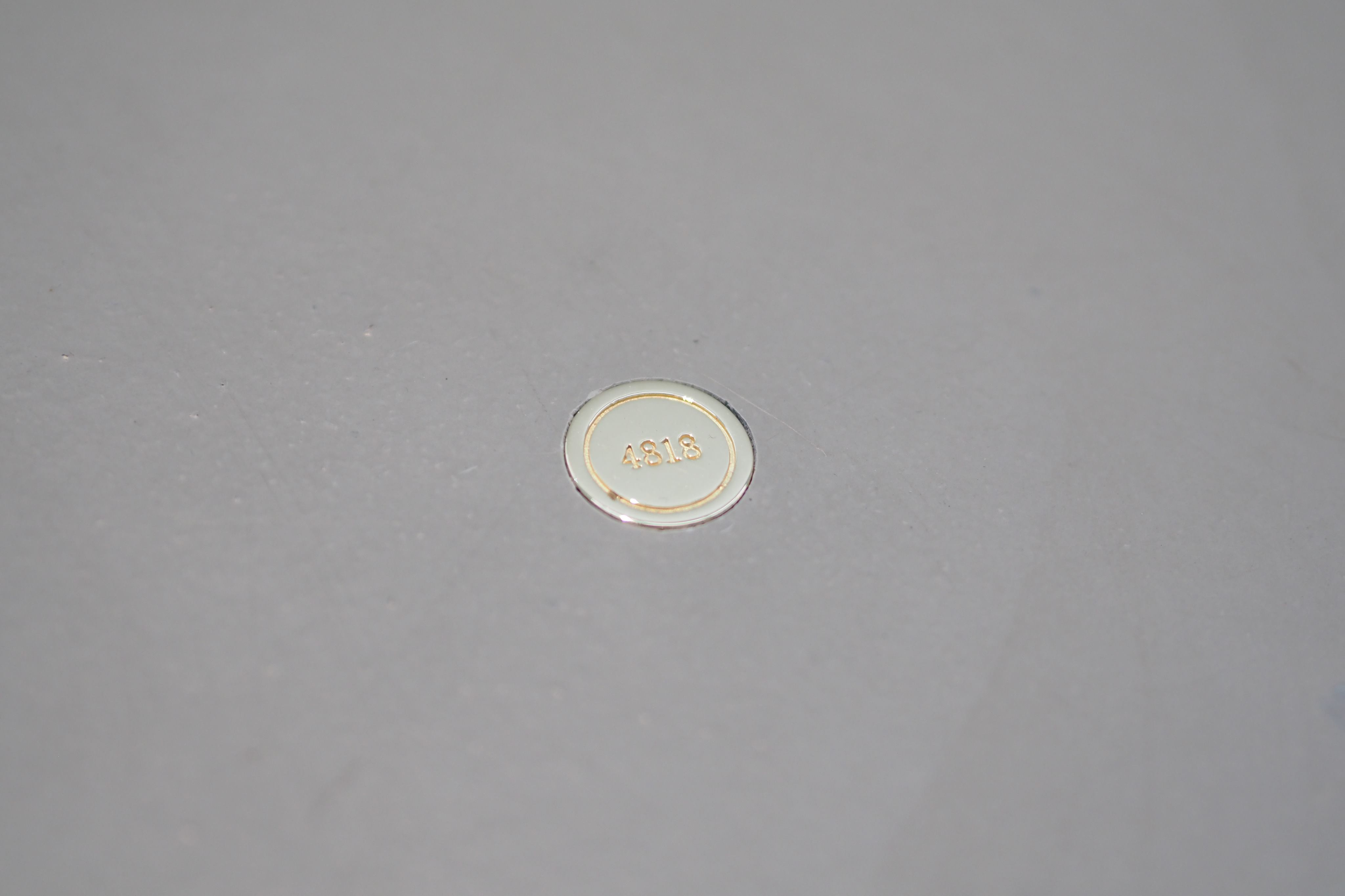
ความเหลื่อมล้ำในสังคมที่เห็นได้จากการถือครองที่ดินปรากฏชัดเจนผ่านบทสนทนาระหว่างชิ้นงาน ตัวตนของหมู่บ้านร้อยล้านถักทอขึ้นเป็นภาพในใจของผู้ชมจากเสียงเล่าในวิดีโอที่ไม่เพียงให้ข้อมูลเกี่ยวกับราคาเท่านั้น แต่ยังเต็มไปด้วยรายละเอียดทำเลที่ตั้งและความเพียบพร้อมของตัวบ้านที่ “ได้ inspiration มาจาก world-class Mediterranean architecture” ถึงแม้เราไม่เห็นภาพภายในโครงการหมู่บ้านที่ว่าในจอวิดีโอนี้เลย ความผิดที่ผิดทางของบ้านรูปลักษณ์ดังกล่าวในภูมิภาคเอเชียตะวันออกเฉียงใต้อันร้อนชื้นก็ประจักษ์ชัดผ่านภาพเคลื่อนไหวที่ถ่ายจากหน้าต่างรถยนต์ที่แล่นผ่านไปในภูมิทัศน์ของชานเมืองกรุงเทพ ราวกับไม่รวยพอที่จะได้เหยียบย่างเข้าไป เราเห็นแต่พื้นที่รายรอบหมู่บ้านเท่านั้น บ้างรกร้าง บ้างเป็นตึกแถวหรือบ้านเดี่ยวหลังเก่า
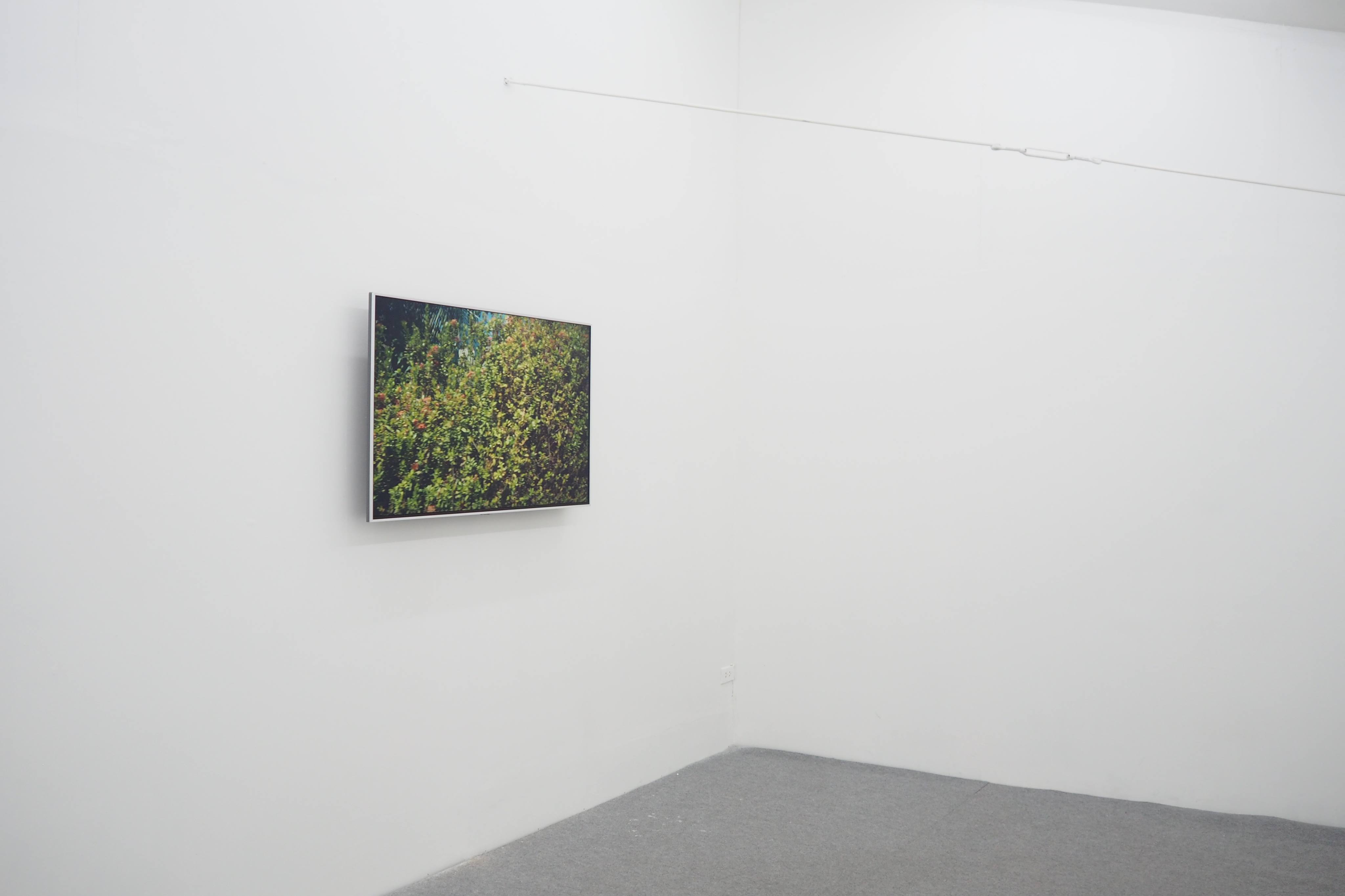
บ้านหลังน้อยของวันทนีย์ก็ไม่ปรากฏเป็นภาพในห้องนิทรรศการเช่นกัน หากหมุดทองคำที่ปักตรึงอยู่บนพื้นก็วางตามตำแหน่งที่ได้จากการคำนวณสัดส่วนของบ้านจริงต่อขนาดพื้นที่ของห้องนิทรรศการ ขึ้นรูปบ้านในจินตภาพของผู้ชมขึ้นมา ตอกย้ำด้วยโฉนดที่ขยายจากขนาด B4 ดั้งเดิมจนใหญ่ขึ้นอีก 12.5 เท่า สลักเป็นลายลงแผ่นกระจก เพื่อที่เราจะมองเห็นถนัดตาถึงแปลนบ้านในโฉนด แผ่นกระจกขนาด 6 x 2.25 เมตรชวนให้นึกถึงความฝันอันยิ่งใหญ่แต่เปราะบางเรื่องการมีบ้าน บ้านเดี่ยวสักหลังบนพื้นที่ขนาดพอตัว ฝันร่วมกันของชนชั้นกลาง
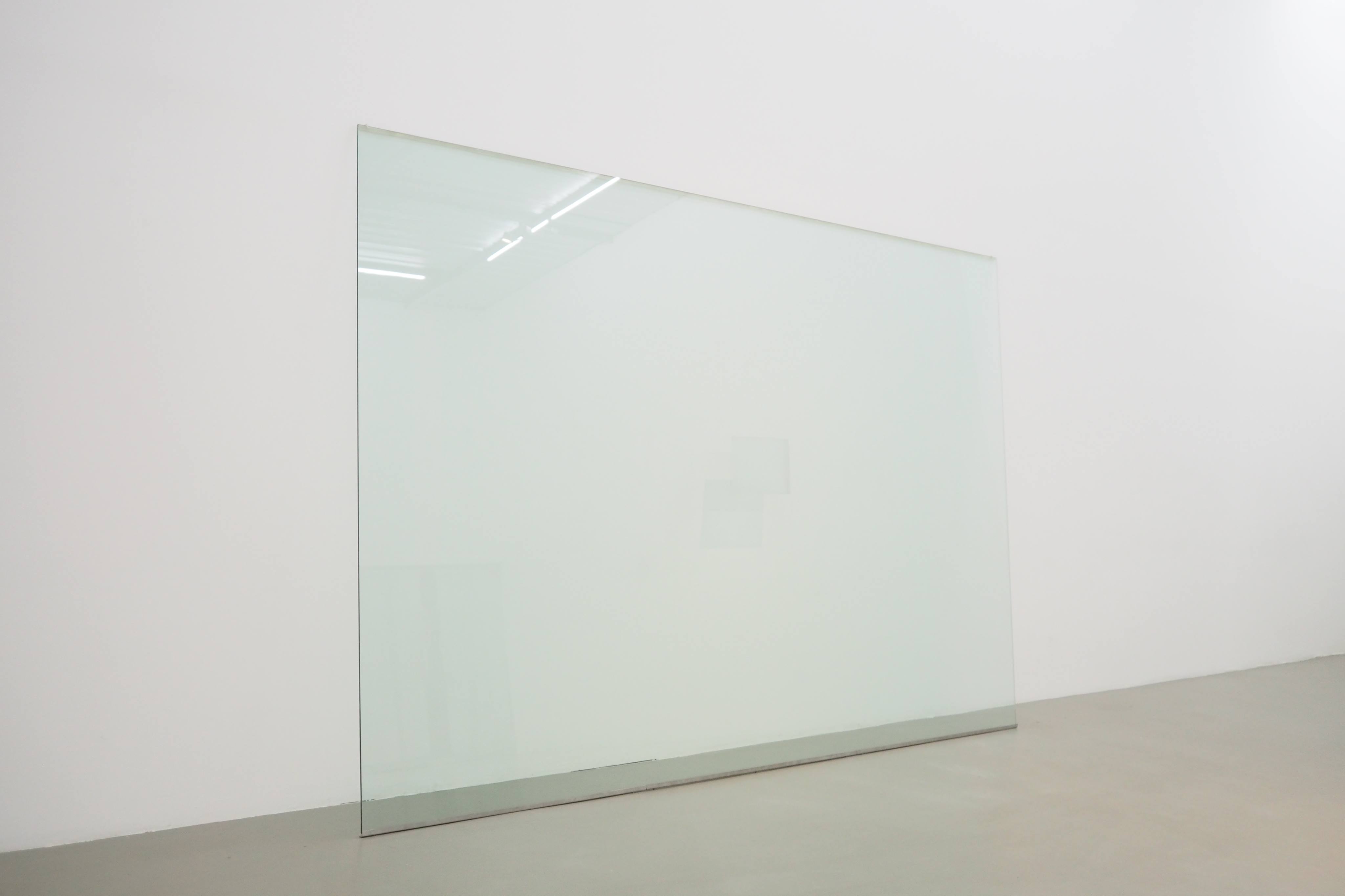
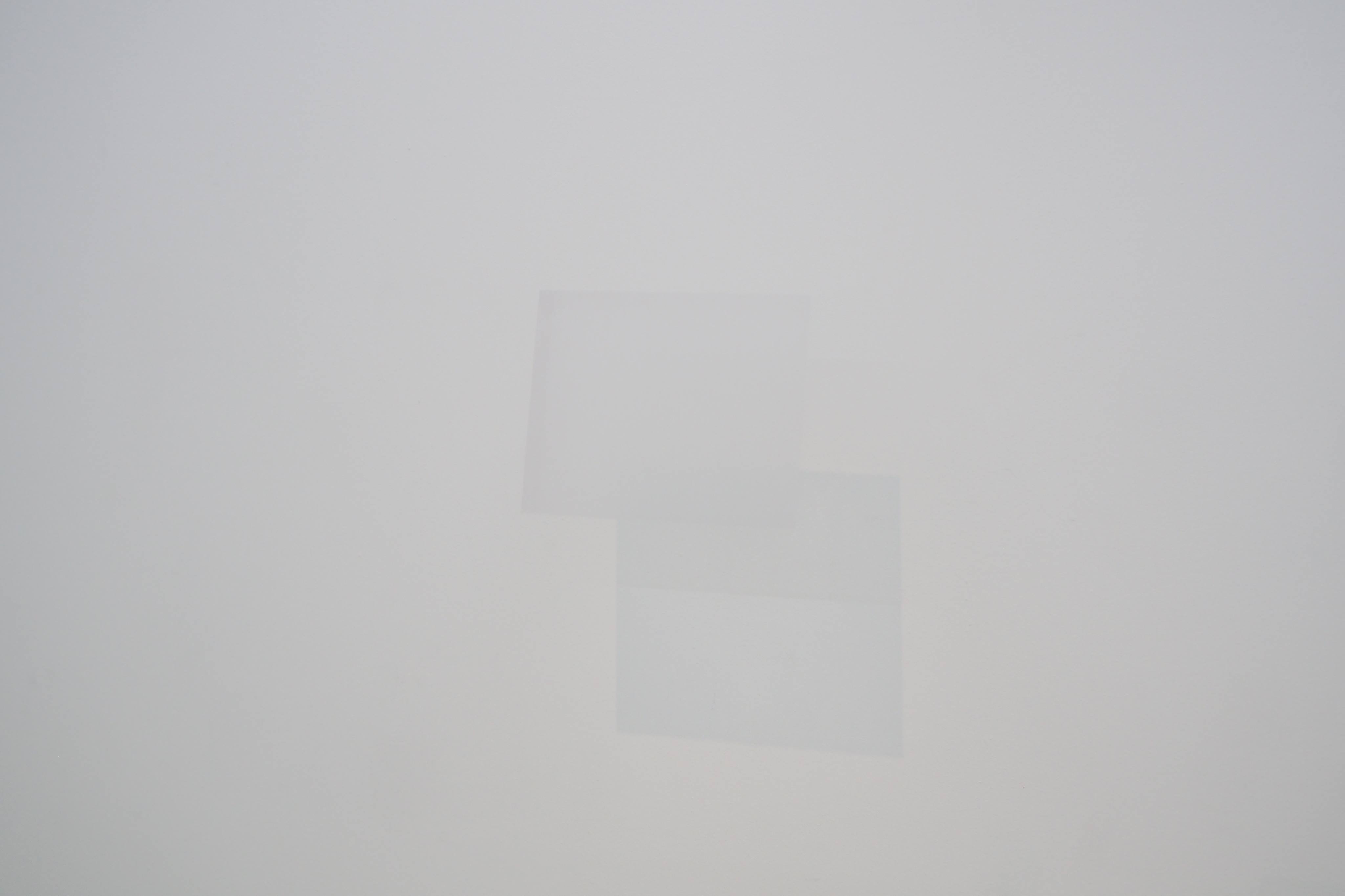
กลางห้องโดดเด่นด้วยแท่นหินอ่อนน้ำหนักกว่าสองร้อยกิโลกรัม ทำหน้าที่ดั่งแท่นวางประติมากรรมอันสูงค่า ทว่าในครอบกล่องอะคริลิคใสกลับเป็นสำเนาของดราฟท์เช็คที่วันทนีย์ใช้ซื้อบ้าน ศิลปะคือสิ่งประมาณค่ามิได้จริงหรือ หากเทียบกับหนึ่งในปัจจัยพื้นฐานอย่างที่อยู่อาศัยซึ่งราคาไม่ได้พื้นๆ ตามไปด้วยแล้ว ศิลปะกลับเป็นสิ่งที่แทบจะไร้ราคา ในเมื่อศิลปินต้องเอางานศิลปะไปขายแลกเงินมาเพื่อซื้อบ้าน หากมิได้เป็นศิลปินระดับโลกแล้ว ราคางานศิลปะชิ้นหนึ่งยังซื้อบ้านไม่ได้ถึงครึ่งหลัง ในกรณีของวันทนีย์ สิ่งที่ทำให้เธอซื้อบ้านได้ยังไม่ใช่งานศิลปะที่เธอสร้างขึ้นเสียด้วยซ้ำไป แต่เป็นอาชีพอาจารย์สอนศิลปะในมหาวิทยาลัยของรัฐต่างหากที่เป็นเครื่องรับประกันว่าเธอจะสามารถผ่อนบ้านไปได้อีกหลายสิบปี
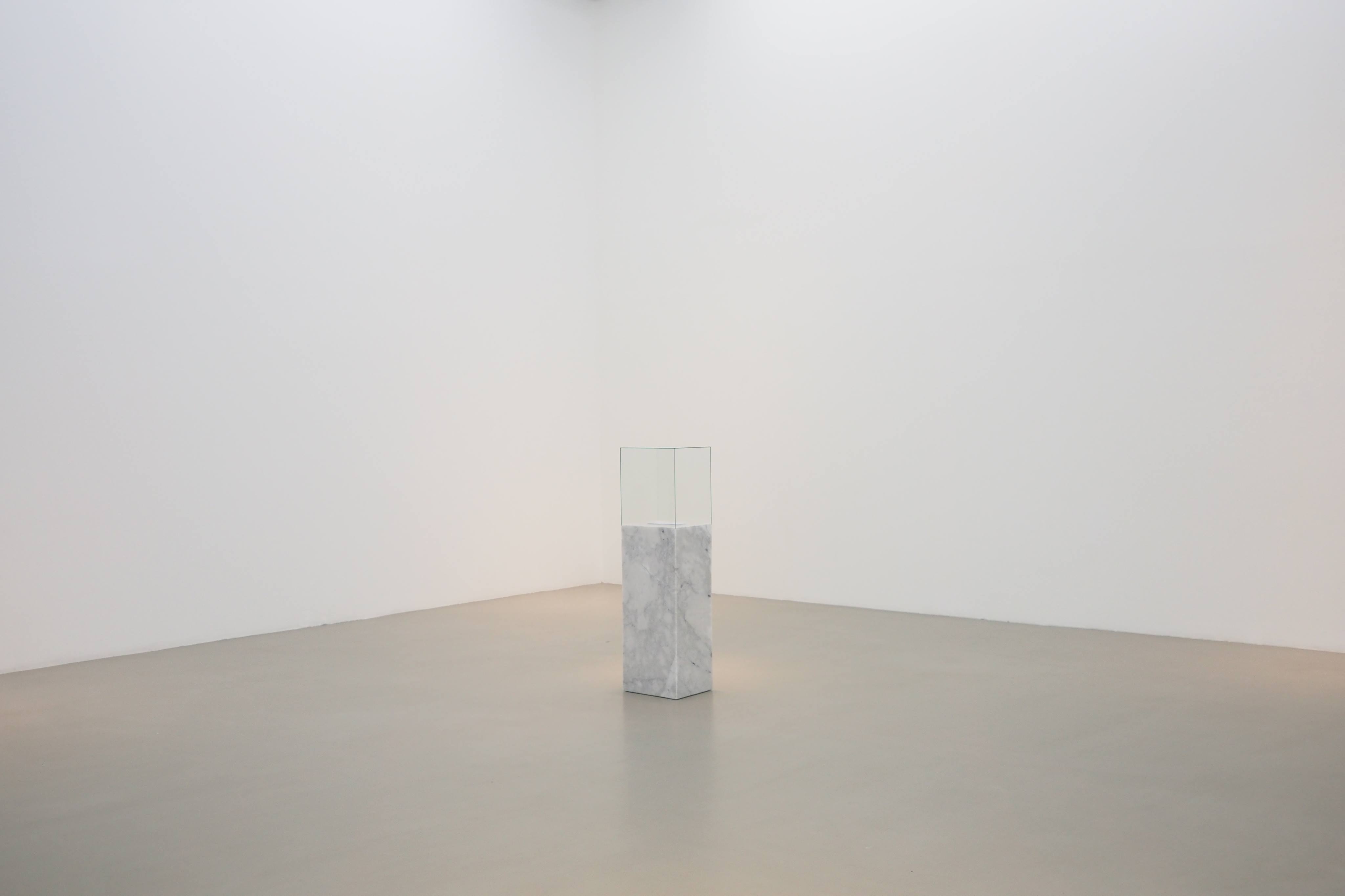
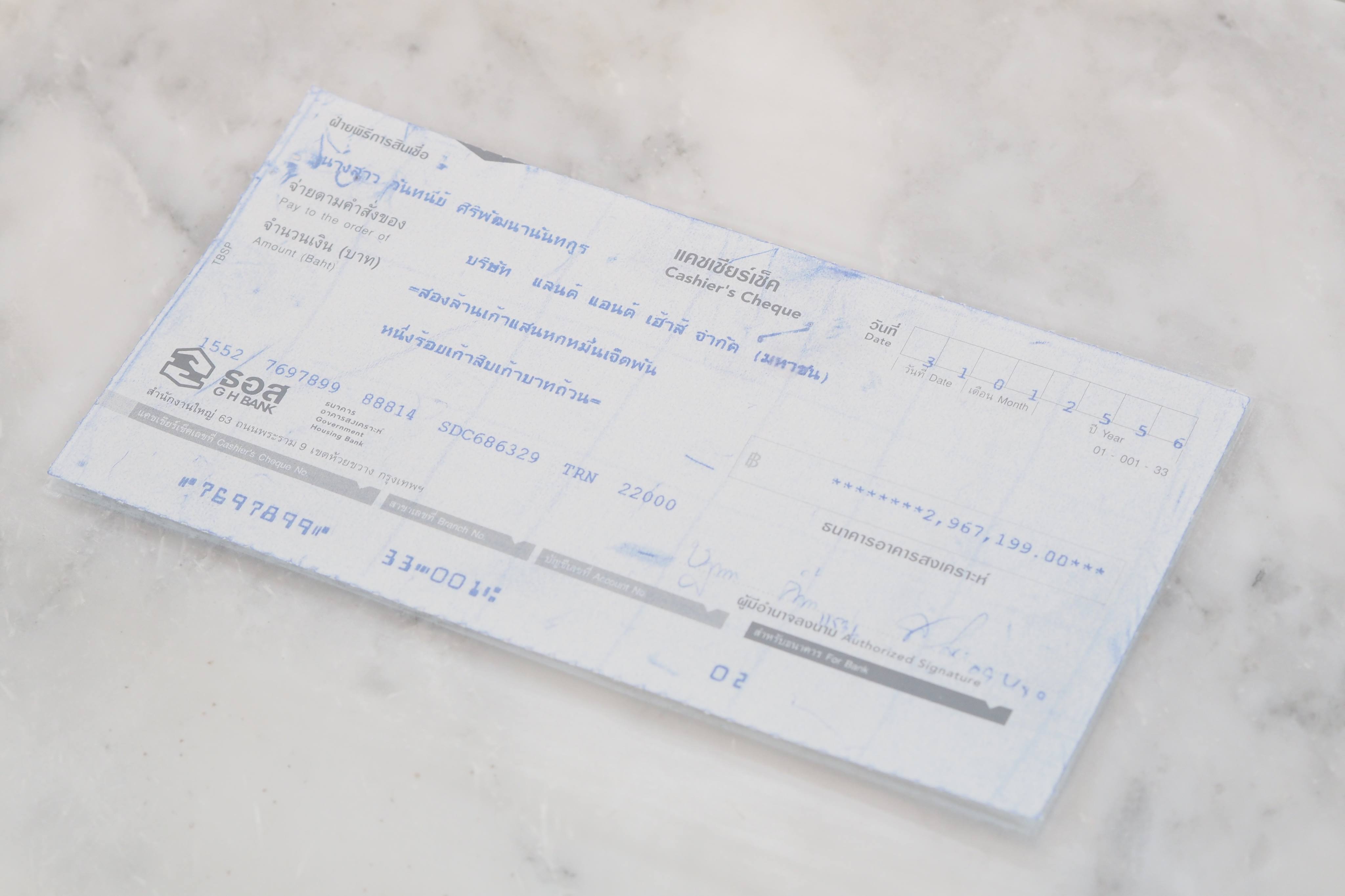
The Broken Ladder หรือ “บันไดหัก” จึงว่าด้วยฝันลวงของการปีนบันไดทางสังคม ในรัฐที่แทบจะปราศจากสวัสดิการ มีคนระดับบนเท่านั้นที่ไต่เต้าขึ้นไปได้เรื่อยๆ เคยได้ยินไหมคำว่า “เงินต่อเงิน” “เหมาโหลถูกกว่า” “ยิ่งรวย ยิ่งประหยัด” เมื่อเราซื้อของทีละมากๆ ราคาสิ่งของต่อหน่วยก็จะถูกลง แต่คนจำนวนไม่น้อยไม่อาจทำอย่างนั้นได้ เพราะพวกเขามีเงินพอจะซื้อได้ทีละชิ้นเท่านั้น ในแง่นี้ การยกระดับตัวเองแทบเป็นเรื่องแสนเข็ญ ประหยัดอย่างไรก็ไม่รวยขึ้นสักที ที่อยู่อาศัยที่เหมาะสมเป็นหนึ่งในหัวใจของคุณภาพชีวิต ดังสำนวน “บ้านคือวิมานของเรา” แต่การมีบ้านต้องแลกกับก้อนหนี้ในธนาคาร สำเนาดราฟท์เช็คบนแท่นหรูจึงเป็นพยานของชีวิตเงินผ่อน เหนือไปกว่าศิลปะและตัวเงินหลักล้านคือเวลาชีวิต... นับจากนี้อีกหลายสิบปี
รสขมในงานศิลปะของวันทนีย์คือความขื่นฝาดร่วมกันของคนจำนวนมากในสังคม สำหรับหลายคน บ้านเงินผ่อนชานเมืองยังหมายถึงการควบรวมรถเงินผ่อนเพราะถิ่นที่อยู่นั้นขาดแคลนขนส่งมวลชนสาธารณะ จะลืมตาอ้าปากกันอย่างไรได้ในภาวะเช่นนี้ ถึงอย่างนั้นก็ตาม ศิลปะที่นำเสนอวังวนหนี้สินก็ทำสิ่งที่เกิดขึ้นไม่ได้ในโลกของความเป็นจริงให้เกิดขึ้นได้อย่างหนึ่ง นั่นคือการนำพื้นที่ของหมู่บ้านสองแบบ สองราคามาซ้อนทาบทับในพื้นที่เดียวกัน ในพื้นที่ของหอศิลป์อันเป็นตัวแทนของโลกศิลปะ อำนาจ ความเป็นเจ้าเข้าเจ้าของและมูลค่าของวัตถุในโลกภายนอกถูกเปลี่ยนมือ หมู่บ้านร้อยล้านเป็นแค่องค์ประกอบหนึ่งในงานของศิลปินที่กำลังผ่อนที่ดินขนาด 50 ตารางวา ในพื้นที่และช่วงเวลาเฉพาะนี้ ศิลปินคือผู้ถือสิทธิในการกำหนดความหมายและคุณค่า ขั้นบันไดหักพังอาจไม่นำไปสู่วิมานในความเป็นจริง แต่ในโลกศิลปะ ความฝันและจินตนาการจะถากทางให้เรายังคงเชื่อในการปีนป่าย ไม่ว่าจะต้องกรีดเลือดหรือตกจากที่สูงไปอีกเท่าไร เพราะสุดท้ายแล้วเราก็ยังคงอยากจะเชื่อ
บทความประกอบนิทรรศการ The Broken Ladder โดยวันทนีย์ ศิริพัฒนานันทกูร จัดแสดงที่ Gallery Ver ระหว่างวันที่ 7 กุมภาพันธ์ - 31 มีนาคม 2561
ธนาวิ โชติประดิษฐ (เขียน)
พจนรรฏ สุทธิพินิจธรรม (แปล)
Tanachai Bandasak (ภาพ)
House/Hope
After the Wang Tha Phra campus of Silpakorn University was indefinitely closed for construction (indefinite like the postponement of Thailand’s election date, the latter equally indefinite if not more so), the four faculties—Faculty of Painting, Sculpture and Graphic Arts, Faculty of Architecture, Faculty of Archaeology, and Faculty of Decorative Arts—have scattered to different sites. The Faculty of Archaeology to which I belong has moved its operations to the Sanskrit Studies Centre near Thawi Watthana canal since the middle of 2016. And for this purpose, the Faculty has set up a Wang Tha Phra-Sanskrit Studies Centre bus service for its staff and students. Then, for the one year period in which there was a road closure around Sanam Luang area for the Royal Cremation Ceremony of His Majesty King Bhumibol Adulyadej, the bus service moved to set off from the Office of the President building in Taling Chan campus of Silpakorn University. But usually, we board the bus by the side of the road in front of the Royal Thai Navy Club near Wang Tha Phra campus.
On January 15, 2018, the first day of term and the first day of the service’s return to the Royal Thai Navy Club, I stood waiting for the bus at its usual spot. After a long while, I realized that the Silpakorn University’s bus which was scheduled to leave at 11 am was parked in the farthest reach of the parking lot instead of by the side of the road as was the case before the Royal Cremation. On that bus were three bus drivers: the actual driver of the bus, and two others of the later buses. Sitting at the front, I could listen in on the tortuous conversation between the drivers. They complained of not knowing where to park. Why did the Royal Thai Navy act like they did not know the bus would park there when the Faculty had already contacted them? And when they tried to park in the regular place out front, they feared trouble with the traffic police. Should they contact the Phrarachawang Metro Police Station which is nearby? What should they do with the orange traffic cones blocking the way? What if they get a parking ticket? What would the officer write on the ticket? And much more. Their conversation got me thinking about the idea of ownership, of power over, and the value of a place. Every inch of ground we step on is owned by someone. The overlapping claims of ownership multiply even further when one reaches the inner Bangkok areas like the Rattanakosin island.
Note: The next morning I waited for the bus at its new spot only to find that it had again moved. After leaving the Sanskrit Studies Centre, the university bus stopped in front of the Royal Thai Navy Club and waited for the passengers to board only for a few minutes.
While power, ownership, value and price are fictional constructs when lands are concerned, they are of utmost importance to our worldly life. Of course, the value of each property differs according to the factors that affect its investment value. The gain from a land isn’t only limited to the agricultural produced from its fertile soil. It relates to a range of businesses, especially tourism and real estate, both of which connect intimately with the setting of the property. The closer to the capital city it is, the higher its price.
Not counting the means of inheritance, it is almost impossible to acquire a house in Bangkok today. Even a condominium unit spanning only a few square meters comes with a sky-high price. When a 22-square-meter room in Bangkok costs as much as acres of land in the countryside, one option for the middle class is to buy either new or old houses (sometimes very old) in the suburbs. Still, the suburbs are not all affordable. Suburban Bangkok, particularly Rachapreuk and Salaya areas, are covered with housing developments for the super rich with homes costing tens to a hundred million baht. Land is as valuable as gold.
In “The Broken Ladder”, an exhibition by Wantanee Siripattananuntakul, four tiny 18k-gold rivets dot the floor of the exhibition space representing the boundary marks of the artist’s own piece of land. For this artist and college lecturer with no executive position, her 50 square wahs (approx. 200 sq. m.) in the suburb has costed her a fortune. There is a discrepancy between her impression of its price and how the super rich seem to feel about the 35-100 million-baht price tags of their homes. For them, it seems to have felt like nothing. A voice from the video clip being played in the small room relates how one hundred out of 234 detached houses in one ultra-lux housing development have already been sold. Near the end of the clip, a real estate agent (not her actual voice, but the content is real) reassures her potential client: “If you buy this today, we can give you a discount from 41 millions to 33 millions.”
Economic disparity manifests itself through the relationship between the different elements in the exhibition. Conjured by the voiceover in the video clip, a housing development valuing in the hundreds millions takes shape in the mind of the visitors. Not only revealing the prices, the voice also relates information about the location and facilities of these houses, which “are inspired by world-class Mediterranean architecture.” Despite not seeing real footage from the development, through a video clip shot out of a car’s window as it passed through Bangkok’s suburban landscape, one can discern clearly how out of place a house of that style would look in the Southeast Asia region with its hot and humid climate. As if we are not wealthy enough to enter its territory, all we see is the area surrounding the development, which is part derelict land and part terraced or old detached houses.
The modest home of Wantanee also does not make an appearance in the exhibition room. Nevertheless, through the gold rivets driven into the floor based on the calculation of the house’s footprint in relation to the exhibition space, the visitor’s mind imagines her house. This image is buttressed by the title deed which has been blown up to 12.5 times its original B4 size, etched onto a pane of glass so that the visitors can fully take in the house’s plan on the deed. This 6x2.25-meter glass pane reminds one of how big and fragile the dream of owning a house truly is, just one detached house on a land proportional to it—the shared dream of the middle class.
Commanding the space in the middle of the room is a 200-kg marble pedestal. While it looks like a pedestal for some valuable sculpture, inside the acrylic box is actually a copy of the cheque that Wantanee used to purchase her house. Is art truly invaluable? When compared to the basic needs like a place of shelter (whose price is far from basic), art worths almost nothing, especially when the artist has to peddle her works to earn enough money for a home. Unless one is a world-class artist, a work of art cannot earn enough even to buy one half of a house. In the case of Wantanee, what enabled her to purchase her home isn’t the art she created. It was in fact her job as an art lecturer at a public university that served as a guarantee that she will be able to pay the mortgage for the decades it would take to do so.
Thus “The Broken Ladder” explores the illusory dream of climbing the social ladder in a modern state where social welfare is pretty much absent. Only the top-tier citizens can afford to prosper. Have you ever heard of the saying “money begets money” or “cheaper by the dozen” or “the richer you are, the better the deal”? When we buy in bulk, the unit price goes down. Yet many people cannot afford to make purchases in this way, since they only have enough to buy one piece of each thing. In these cases, progress on the social ladder is nigh impossible, and being frugal doesn’t seem to offer much relief. A proper home is one of the essential elements of a good life, as the saying goes: “Home is where the heart is.” But to own a home one must also accept a mortgage with the bank. The copy of the cheque on the fancy pedestal is a testament to a life lived under mortgage, for even more costly than a piece of art or the millions baht payment is the cost of our time, the decades of our life.
The bitter taste of Wantanee’s work is felt by many in our society. And for a large number of people, mortgaged homes in the suburbs further entail the burden of a loan on a car, since there is no public transport in such areas. How can anyone get ahead under such circumstance? Still, this artistic statement of being in debt has rendered possible one thing that would otherwise be impossible; that is, it layers, one on top of the other, two properties of different values. In the space of the gallery, which represents the art world of power and ownership, and of economic exchange value, a housing development with homes costing in the hundred millions becomes only one component in a work of an artist striving to pay off her mortgage on a 50-square-wah home. In this space and at this time, it is the artist who holds the power to assign meaning and value. While a broken ladder may not lead us to the home of our dream, in the world of art, dreams and imagination continue to fuel our belief in a better future. So we labour on no matter how thorny the way or various the falls—because when it comes down to it, we want to believe.
House/Hope is written by Thanavi Chotpradit for the exhibition catalogue 'The Broken Ladder' by Wantanee Siripattananuntakul. The Broken Ladder is on view at Gallery Ver from 7 February to 31 March 2018.
Translation: Pojanut Suthipinittharm
Photographer: Tanachai Bandasak
Tweet
In the exquisite carved and gilded frames that hung on the wall above the horizon line is the matted and stained sheep’s wool. Dirty as it seems, the wool was taken from stray sheep wandering around the village of Ru-Sa-Me-Lae, a small village in Pattani. Pattani is one of the three provinces (Pattani, Yala and Narathiwat) in the Deep South or the Patani region, the southernmost part of Thailand. It is a predominantly Islamic region where the protracted conflict between the Thai state and the militants aiming to liberate Patani and establish a Malay Islamic State, Patani Darussalam, has been consuming thousands of lives for decades. The Deep South has long been a subject of study of violence and state oppression.
ละครเวทีเรื่อง “ซูเปอร์ พรีเมี่ยม ซอฟท์ ดับเบิ้ล วานิลลา ริช” (Super Premium Soft Double Vanilla Rich) ของคณะละครเชลฟิตช์ (Chelfitsch) เขียนบทและกำกับโดยโทชิกิ โอกาดะ (Toshiki Okada) เสียดสีสังคมบริโภคนิยมของญี่ปุ่นและความจำเจแต่เสแสร้งของงานบริการผ่านการเล่าความเป็นไปในร้านสะดวกซื้อ 24 ชั่วโมงชื่อร้านสไมล์ แฟคทอรี่ ตัวละครทั้งเจ็ด ได้แก่ พนักงานชายสองคน คนหนึ่งเป็นจอมป่วน อีกคนหนึ่งดูธรรมดา ผู้จัดการร้านแสนดี พนักงานฝึกงานสาวผู้มีอาชีพหลักเป็นนักแสดงละครเวที ซูเปอร์ไวเซอร์จากสำนักงานใหญ่ ลูกค้าสาวขาประจำที่มาซื้อไอศกรีม “ซอฟท์ ดับเบิ้ล วนิลลา ริช” อย่างเดียวทุกคืน และชายหนุ่มนักต่อต้านผู้แวะมาพูดจาก่อกวนที่ร้านทุกวัน ผลัดเปลี่ยนกันออกมาสร้างเรื่องเล่าเกี่ยวกับสังคมสมัยใหม่ที่ทุกคนตกเป็นทาสของวัตถุและการค้าอย่างหลีกเลี่ยงไม่ได้
ไม่ว่าจะตระหนักถึงนัยการเมืองของศิลปะหรือไม่ นิทรรศการ SILPA: TRANSFORM กาย-วิพากษ์ได้ดึงเอาประเด็นที่น่าสนใจที่สุดประเด็นหนึ่งในประวัติศาสตร์ศิลปะไทยสมัยใหม่ อันได้แก่ การแสดงภาพร่างกายขึ้นมา ทว่าน่าเสียดายที่ยังไปไม่ถึงการ “วิพากษ์” ในความหมายของ “critique” คือการวิเคราะห์แจกแจงโดยละเอียดถึงนัยการเมืองของการให้ภาพร่างกายที่เกาะเกี่ยวอยู่กับรอยต่อของความเปลี่ยนแปลงอุดมการณ์ทางการเมือง รูปแบบทางศิลปะหรือ “สไตล์” ที่ส่งผลต่อการนำเสนอภาพร่างกายในยุคที่ศิลปทำงานนั้นสัมพันธ์อย่างแนบแน่นกับสำนึกเรื่องชนชั้นทั้งก่อน ระหว่างและหลังการเปลี่ยนแปลงการปกครอง 2475 เมื่อเป็นเช่นนี้ ถึงแม้จะมีแยกส่วนร่างกายออกมาเป็นภาพร่างมากมายบนกระดานดำ “กาย-วิพากษ์” ก็ยังเป็นแค่ “กายวิภาค” แต่ยังไม่ถึงกับ “วิพากษ์กาย”